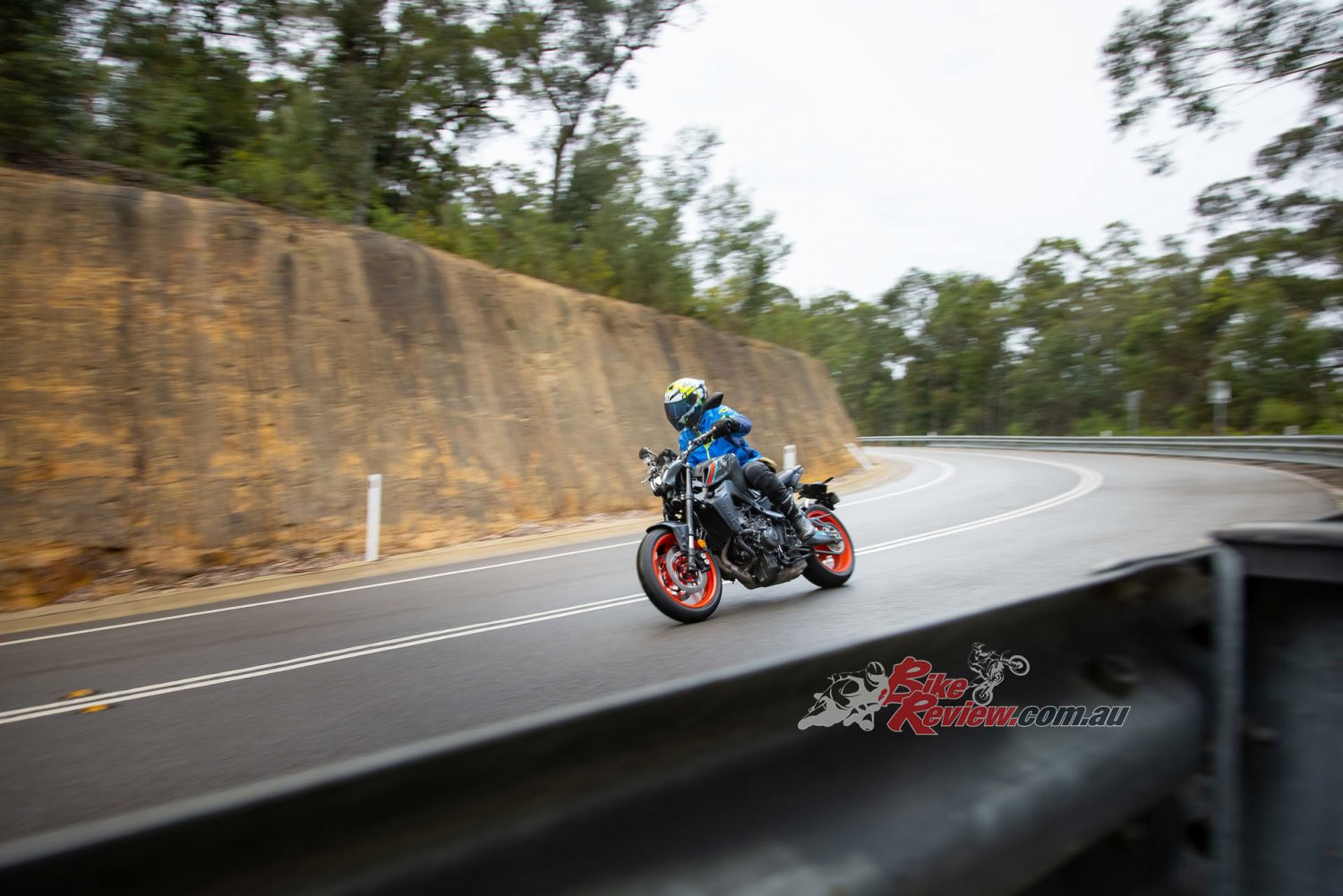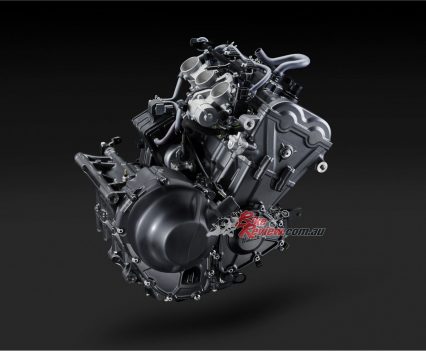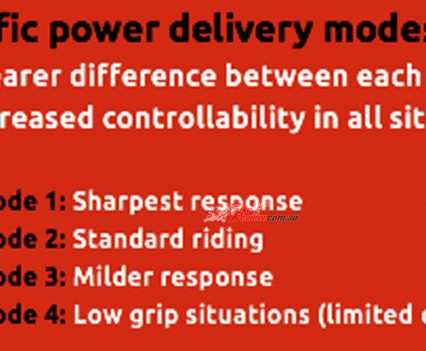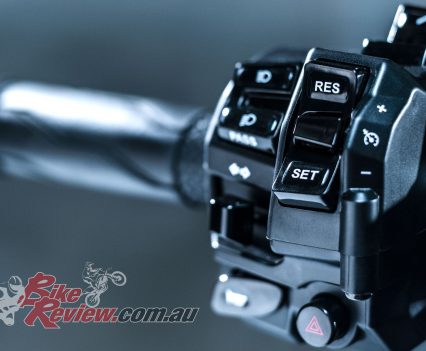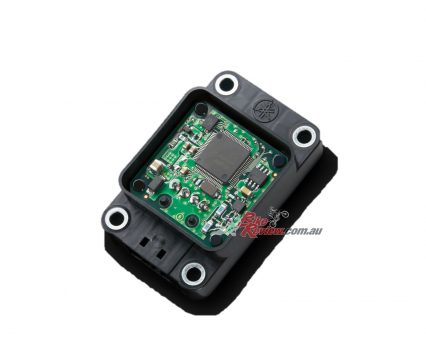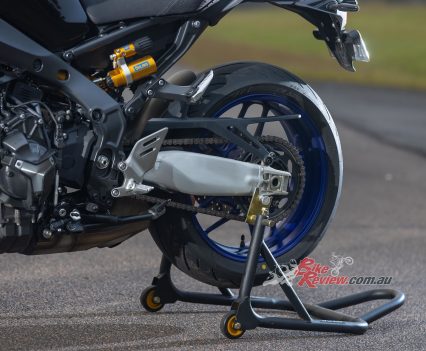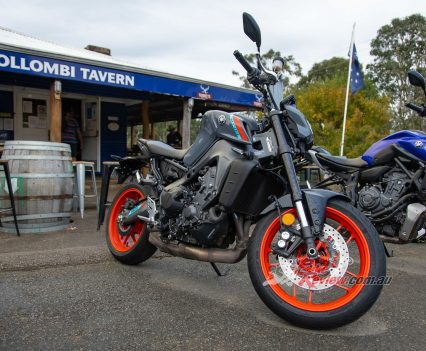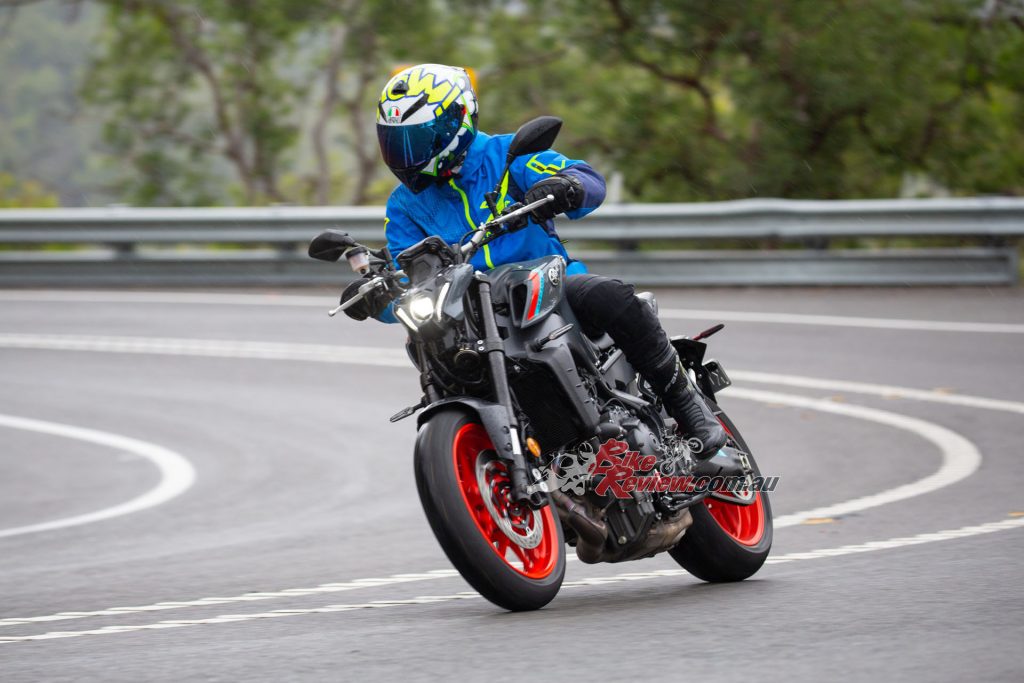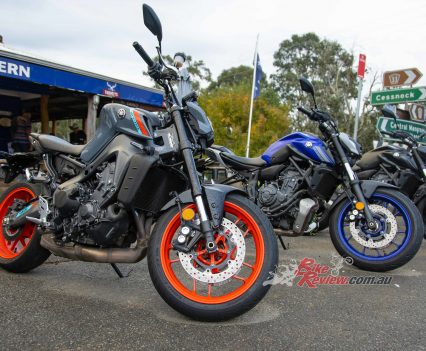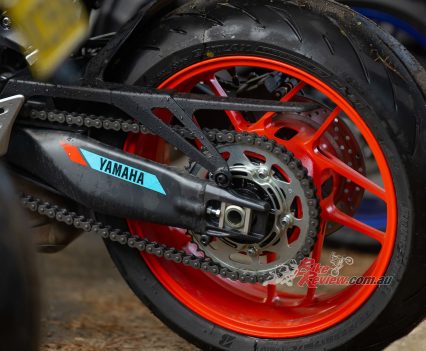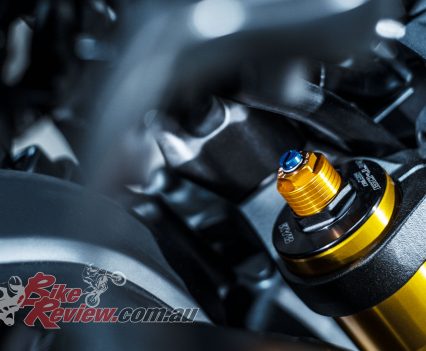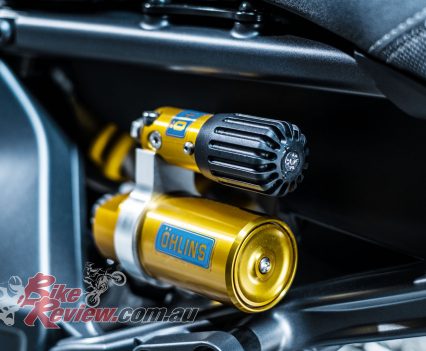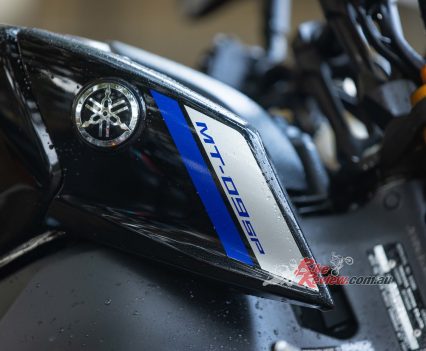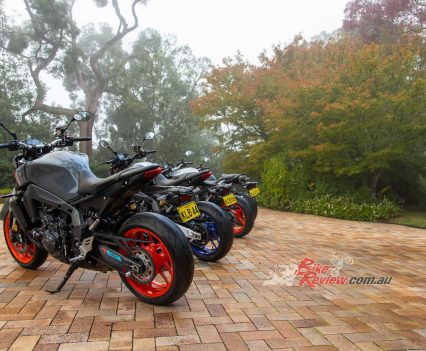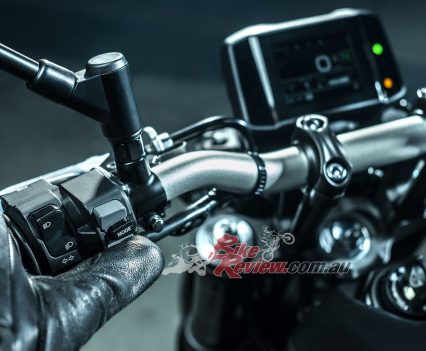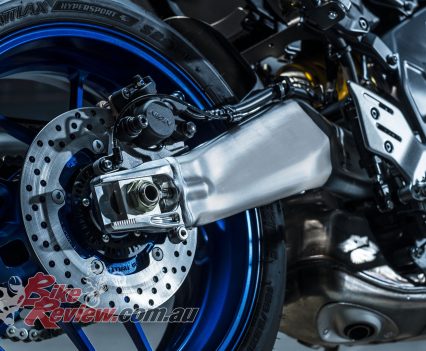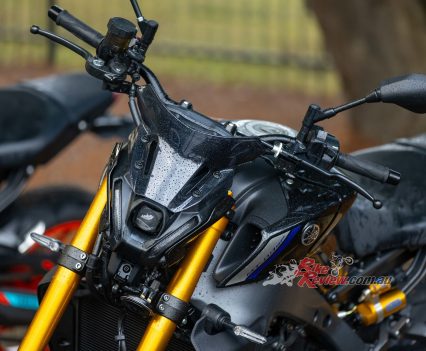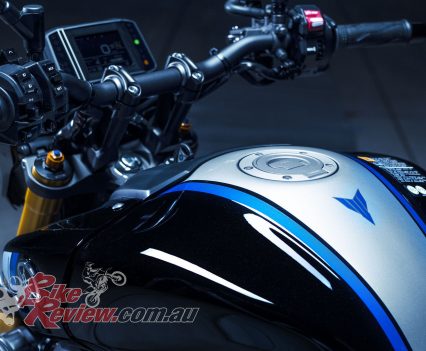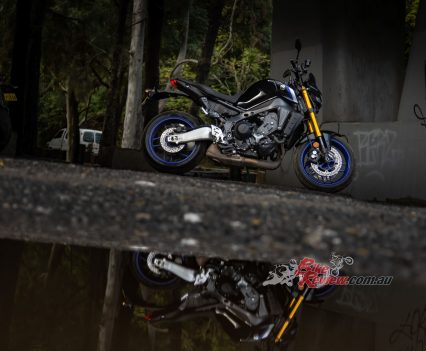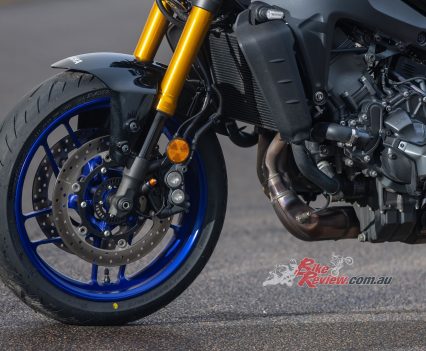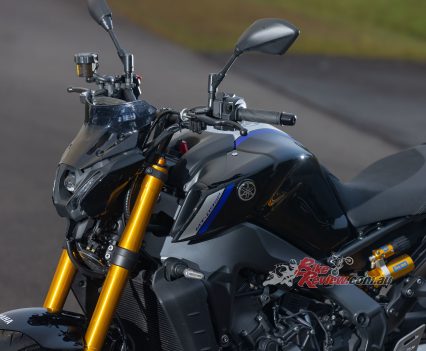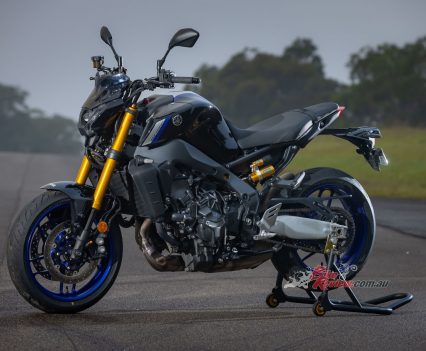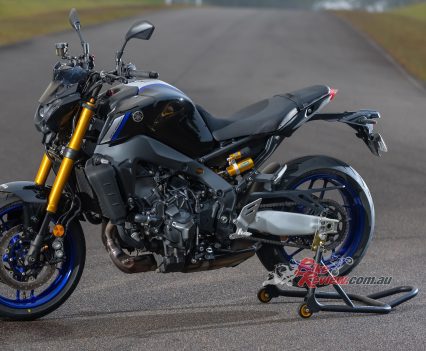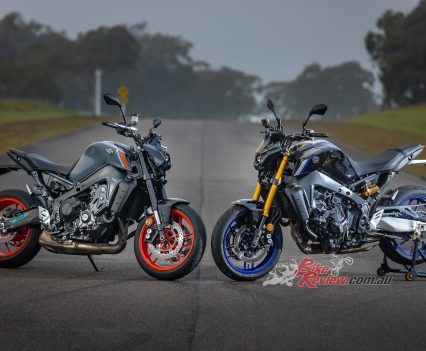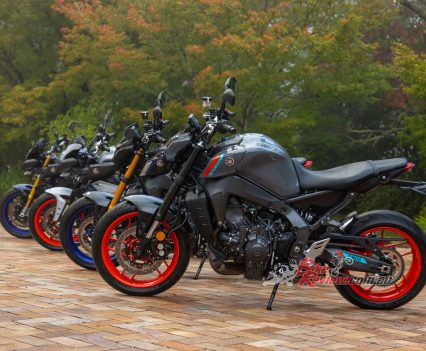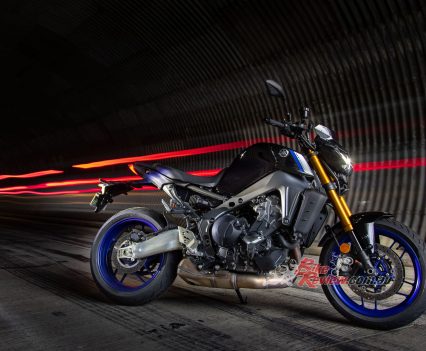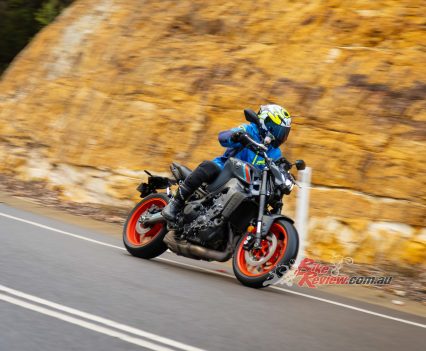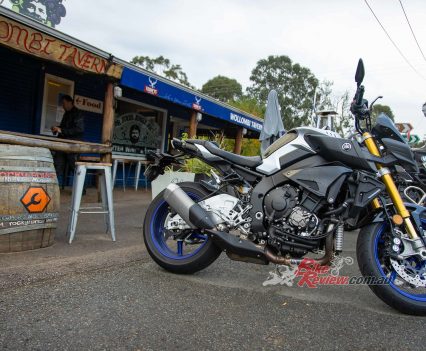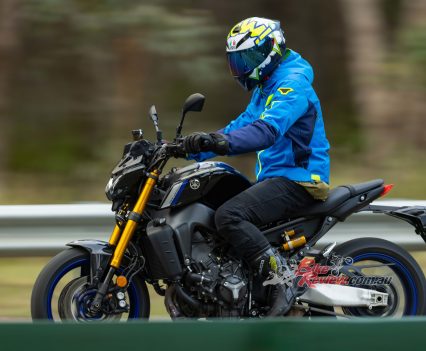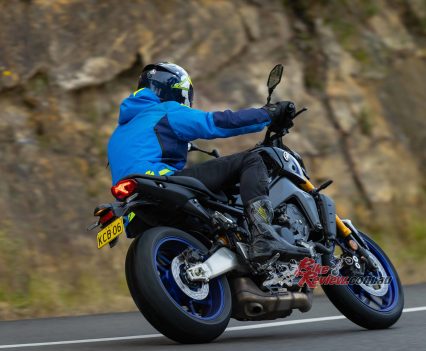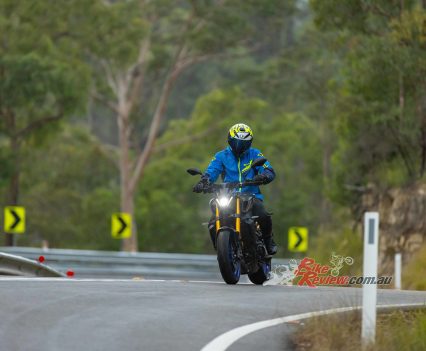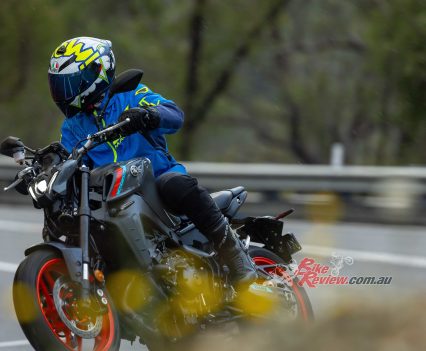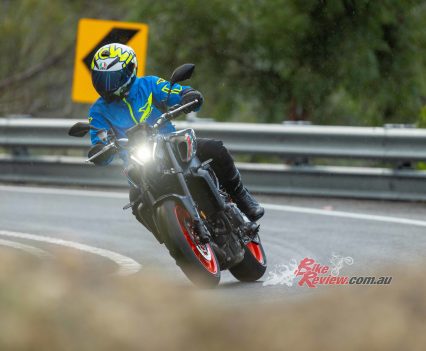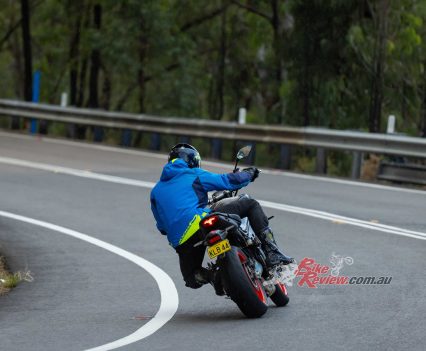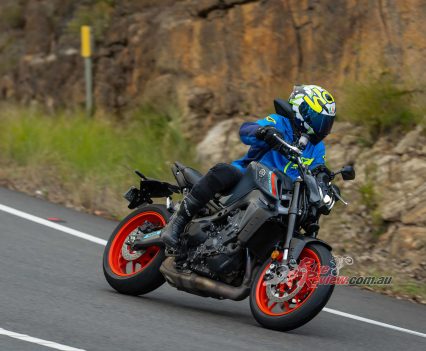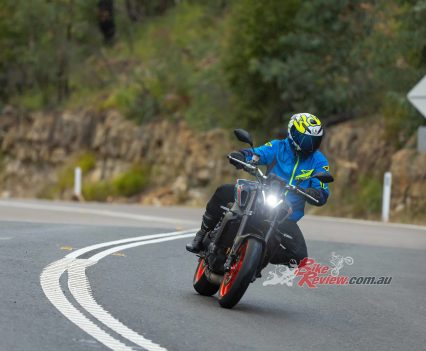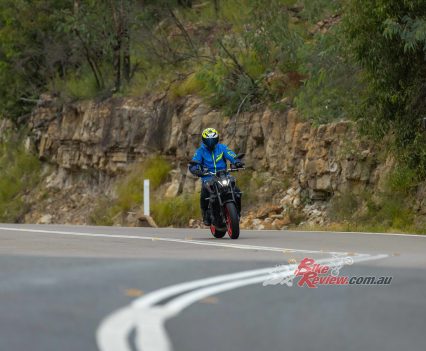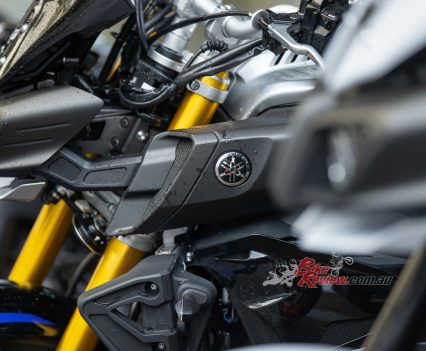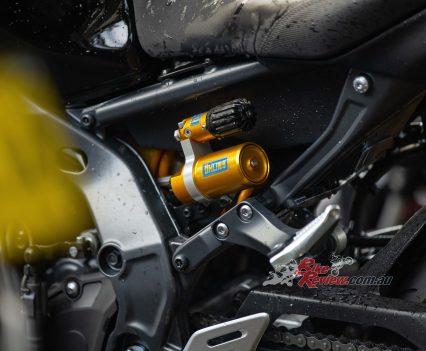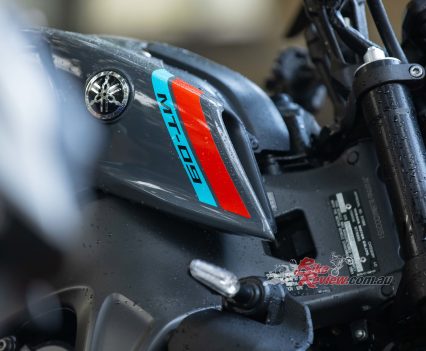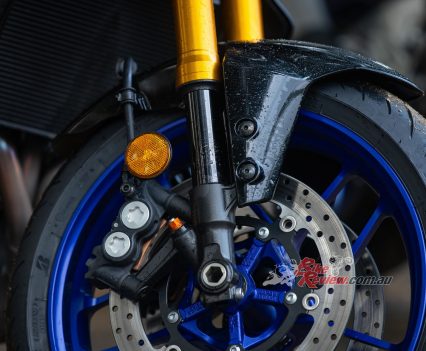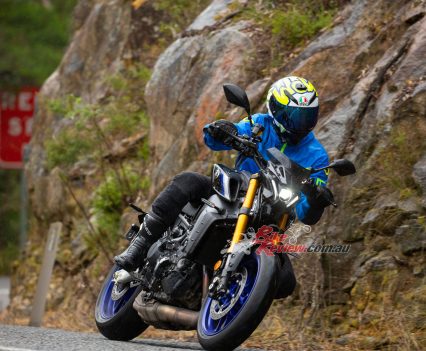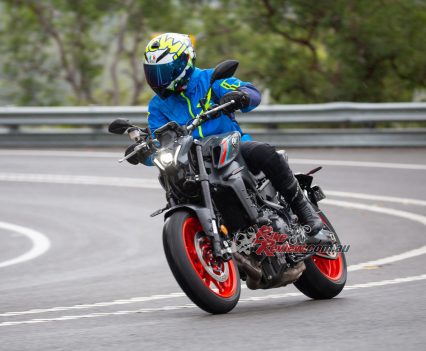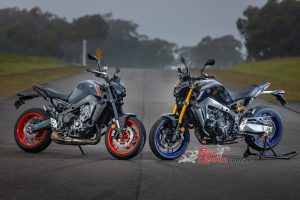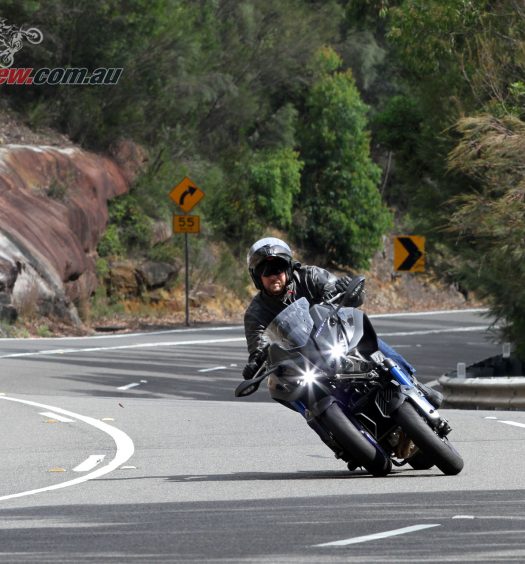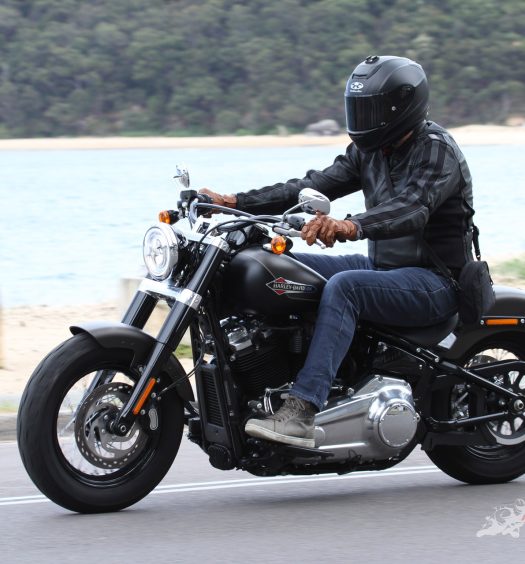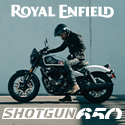They both excelled on track but how do the updated 2021 MT-09 Standard and SP models perform out on the road? We go for a splash on both to find out...Review: Zane Dobie Photography: iKapture.
Jeff covered the track test on the new MT-09 models last month and it was Zane’s gig to do the road miles. Bad luck, it pissed down, but that didn’t stop him having a blast. Riding the 2021 Yamaha MT-09 and MT-09 SP was always going to be a riot, wet or dry… Here’s Zane’s review.

The 2021 Yamaha MT-09 has been given a complete make-over, but has it worked? Simply put, yes it has.
At a glance the reworked MT-09 echoes almost nothing of its predecessor, the entire bike has been rebuilt from the ground up working on the issues uncovered from the previous model. Most notable is the change in riding position and the headstock being lowered by a big leap of 30mm.
Read Jeff’s track test & Tech Details of the 2021 MT-09 & MT-09SP here…
I never got a chance to give the previous MT-09 a decent thrash but I did manage to try one out a few years ago and it didn’t feel like the rest of the range. It lacked an aggressive riding position and when it came time to ride the Tracer 900, I could see why Yamaha opted for a more relaxed riding position for the old generation MT-09, as a base for their Grand Tourer model.
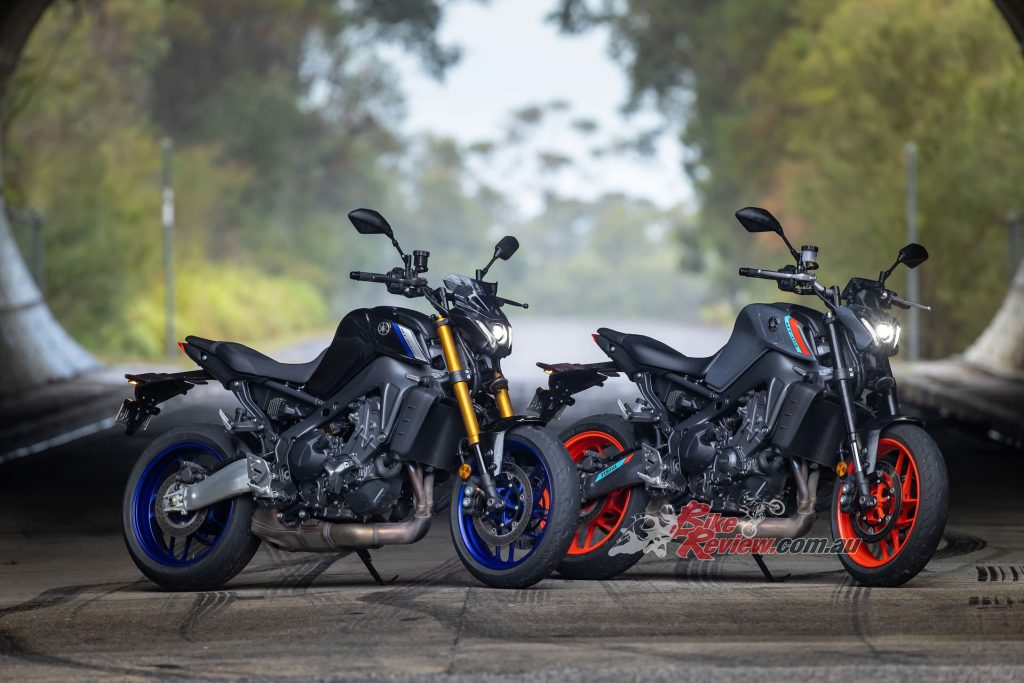
Both the 2021 Yamaha MT-09 SP (L) and MT-09 (R) are available now for $17,299 and $15,249 Ride Away.
It goes without saying that the Yamaha hit the nail on the head with the new motor. Taking the three-cylinder engine back to the drawing board and giving it a 42cc upgrade by granting it a 3mm longer stroke. Not only has this increased the capacity, but it also has sling shot the triple to 87.5kW@10,000rpm and 93Nm@7000rpm.
“It warms my heart to see power increasing and emissions lowering”…
Given the ever-strengthening Euro5 regulations, I have been waiting to see where the peak engine power from manufacturers is before they start breaking rules. It warms my heart to see power increasing and emissions lowering.
It’s not just the environment benefiting from the lowered emission, but the riders too as the manufacturer claims the new engine boasts a 9 per cent efficiency boost. The dash stated my bike averaging between 5-6L/100km during my test, which is ample considering the small 14L tank.

Early RbW systems were irritating when it came to throttle lag. Fortunately, Yamaha have improved the system for the 2021 model MT-09 and MT-09SP.
New for 2021 is a RbW system replacing the conventional cable throttle. When manufacturers began making the move to this system I wasn’t exactly on board, the early systems had issues that made riding unpredictable as well-as unenjoyable. Luckily for Yamaha they have figured all of this out, with the system feeling nearly identical to a conventional cable system. This means riders get better fuel economy and we can have the accurate cruise control as seen on the SP model only.
The new RbW system allows for adjustable engine maps as well, the four power modes include mode 1: sharpest response, mode 2: standard riding, mode 3: milder response, mode 4: low grip situations (limited output). All four have noticeable changes and allow riders to switch through depending on road conditions. This increases the general rideability of the MT-09 as a whole, ensuring that you’re not constantly throwing the front wheel up when the lights go green or losing traction in the rain.
Something I’ve always complained about, possibly because I’m a winging Millennial, is the lack of TFT screens used on Yamaha’s range. Manufacturers such as Triumph and even CFMOTO have had these at the forefront of their range for years, but the Yamaha has lagged behind with a basic LCD screen. Yamaha have listened to their riders and decked out the standard and SP models with a new full colour TFT dash. It is pretty basic and unfortunately Bluetooth has been left out.
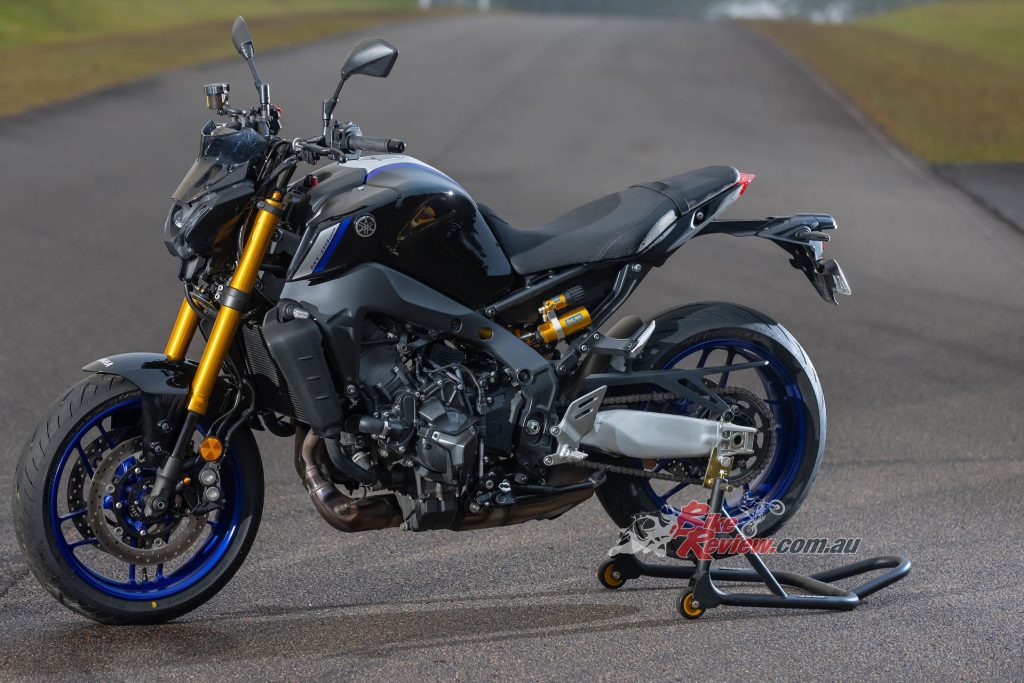
The SP model doesn’t feature many differences to the standard, with the main upgrade being the suspension.
Considering turn by turn navigation systems and Bluetooth connectivity are popping up on lower-range models from other manufacturers, it’s strange Yamaha haven’t chosen to go down that road yet. If you were to own one I’m sure it wouldn’t be all that difficult to get used to, but setting up the assist profiles and the multiple steps you need to go through to turn the TCS off was a pain. I’d say the usability aspect of the interface may need to go back to the drawing board for the 2022 model.
The main difference between the SP and standard model is the suspension. Both feature a KYB branded USD front set-up, both are 41mm and both are fully adjustable, but the SP has high and low-speed damping, adjusting to suit your ride style. The rear is a KYB monoshock with adjustable preload and rebound on the standard, but the SP gets an Ohlins fully adjustable set-up. Coming in at just over $2000 for the SP for different suspension, cruise control and some aesthetic changes, I was itching to see if it was worth the money.
The Ride
On the day of the road ride, we were unfortunately soaked (the most rain in Sydney in five years). I was welcomed to my first taste of the MT-09’s plethora of rider assists. Not even five minutes into the rainy ride, while leaning the standard MT-09 over into a roundabout, a courier truck had pulled out directly in-front of me. I was given two choices, either end up as mince-meat on the road or grab the brakes and hope I don’t drop the only available standard MT-09 during the entire launch.
To my surprise, the new Bosch 9.1 MP pump allows the cornering ABS to work its magic, not only did I escape a trip in an ambulance, but the motorcycle stayed off the road too. Grabbing the brakes stood the MT-09 directly up and to an almost instant halt, it was so effective that I even had time to hold down the horn, lift my visor up and yell expletives at the truck driver.

Yamaha have gone with their home-brand for the brake caliper set-up in 2021, but they still felt improved over last years model on the SP due to the radial master-cylinder.
There is no usage of the common Brembo or Nissin brake calipers for the MT-09 this year, instead Yamaha have kept it close to home by using twin 289mm rotors up front with their home brand four piston calipers. To most people they would be indistinguishable to a more aggressive set-up and compliment the bikes weight and usage of cornering ABS well. Combined with the Bridgestone Hypersport S22, the bike has absolutely zero issues coming to a safe stop.
Thanks to the pouring rain, I had the MT-09s set to full TCS and the lowest power for most of the day. I’m certainly impressed with how they performed in the rain, even through the twisties surrounding the Hunter region, there was not a single time I felt like the motorcycle was going to wash out from underneath me. This is partly thanks to the 6-axis IMU measuring acceleration, pitch, roll and yaw ensuring that I could use the tyre tread and lean the MT-09s over as much as I felt comfortable in the rain. Not only did it feel completely in-control for the entire road ride, but the TCS didn’t cut in constantly with the power cut being incredibly smooth and almost unnoticeable.
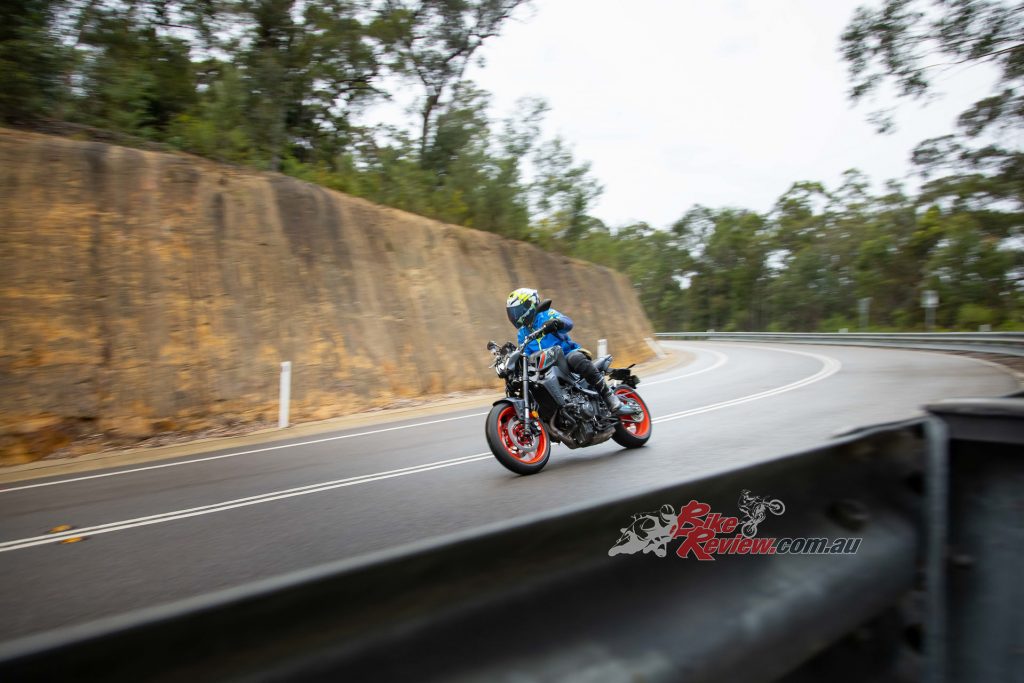
The brains at Yamaha have come up with a way to seamlessly keep riders safe in the wet with their 6-axis IMU.
I have been speaking about the MT-09 as a whole due to the SP model feeling almost identical to the standard on the road, the suspension set-up on both manage the pot-hole infested roads of NSW perfectly. The most noticeable difference came in the form of comfort while road riding on the lower spec standard model. MT models tend to suffer from backbreaking rebound on their rear suspension set-ups, however, the KYB set-up seemed to soak up most of the bumps throw at it.
I did notice some difference between the two when it came to picking up the pace through the corners, the SP low/high speed damping felt slightly more planted through the corners thanks to its stiff set-up. If you are looking to keep the bike away from tracks and do mostly road riding then I recommend the standard model. It may have just been because i was taking it so easy in the rain. Jeff noticed a big difference between the SP and standard at the 70North test, with the SP much better handling.
I was slightly confused why Yamaha didn’t consider to include cruise control on the standard model and kept it for the SP as they share most of the same components. It could be a marketing idea in order to create more options for the premium model. Is it enough for me to opt for the SP? Probably not, I would put that $2000 towards some modifications like a tail tidy and Akaropovic exhaust system to really hear that three-cylinder growl. It’s not comparable the chunky MT-10 and MT-10SP which felt like night and day between the two models, it really needed a little bit more.
The engine has to be one of my favourites to come out of the Iwata factory in Japan (besides the two-stroke era). I have nothing but good things to say about how the motor performed on the road, the beauty of adjustable engine maps and a high rpm peak power means you’re not constantly having to grab the brakes when just commuting. I felt in-control at all times, not only when short shifting while lane-splitting in traffic, but when seeing what it was made of through the twisties. I’m convinced there’s no greater feeling of the front wheel lifting off the road when the tachometer is showing 10,000rpm!
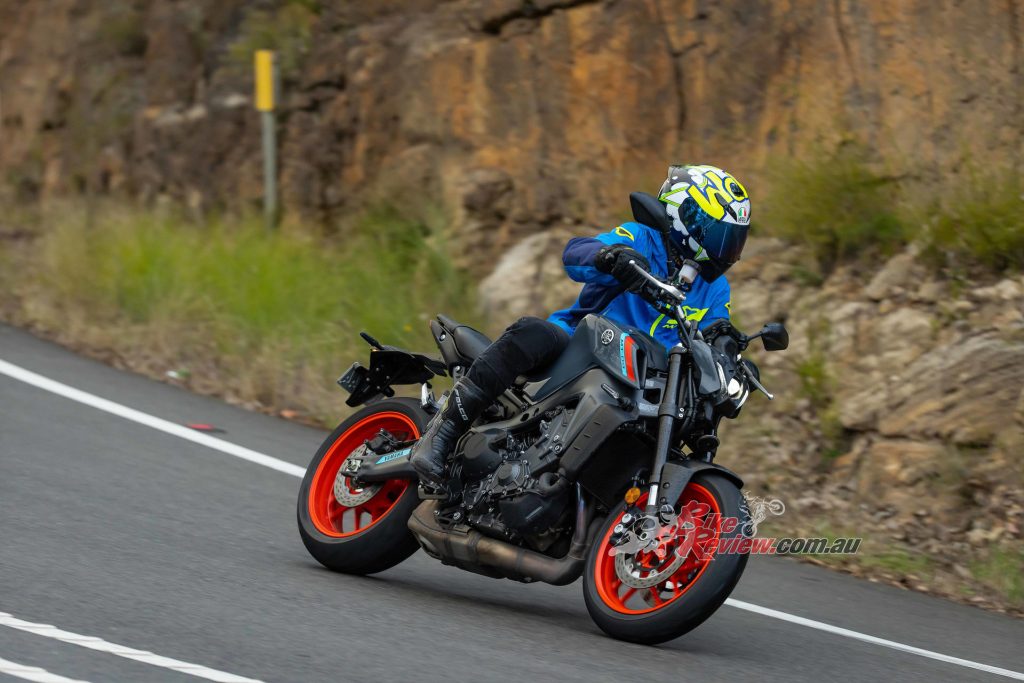
Peak power is at 10,000rpm, which means when you stretch the legs of the crossplane engine, you are rewarded with a bucketload of power.
Somehow, Yamaha have made the three-cylinder sound like an absolute monster through their Euro5 approved exhaust system. I honestly can’t wait to hear one without all the restrictive gear in it. The sound is further enhanced by the pops and crackles given off by the lightning-fast quick-shifter, just a light touch of the shifter will snap your neck the first time you ride the MT-09 as it’s one of the best systems Yamaha have put on their machines. The downshift is also supported by the quick-shifter, ensuring you don’t lock up the rear when clicking down too far thanks to their slipper clutch.
Being a fan of anything with low-power, I tend to stray away from high capacity bikes for my personal collection, this means I’m used to how slower bikes act when releasing the clutch. When it came to the MT-09, the clutch works wonders to ensure a smooth take off even though its sporting 93Nm of torque. At no stage when leaving a stop did the bike feel like it was just going to take off from underneath me or stall, it acted like a lower capacity bike until you really wanted to give it the beans.
When it came down to how the bike actually felt to sit on for hours at a time, I was pleasantly surprised at how Yamaha kept the ergonomics comfortable for freeway riding but left enough footpeg clearance. Despite the headstock being lowered, you still didn’t have to lean forward too far to grab the handlebars, instead it still had that MT appeal of an upright seating position with a more in-control and sporty appeal thanks to bar riders.
I’m aware that the aesthetic design of the headlight seemed to cop some slack online but it’s honestly one of those bikes that look better in person. Other design features such as the tank not only give the bike those sharp lines but added to the stability. Being 182cm, my knees tucked up nicely against the tank which helped a lot with leaning off the side with plenty of confidence. While I would consider myself tall, I wasn’t the tallest at the launch yet I didn’t hear any complaints from the other Journalists about the legroom or seat height.

No more wrestling the bike to get it to turn in this year, there have been plenty of improvements made to ensure rideability of the new MT-09.
All the changes to the suspension, riding position and headstock height combined with the new CF diecast aluminium sub-frame transformed how it handled fast corner changes and initial turn in. The bike didn’t act like its weight class at all, instead just went wherever you pointed it and fell on its side with ease. I can see this being a great bike for riders looking to improve their skills through turns as all you have to focus on is your lines and not wrestling the bike on the initial turn in, which is more than what can be said about the previous generation.

With the rideaway prices being so affordable, theres not much out there with better value for money.
It’s not often I hop off a full-power bike not wanting to crawl back onto a lower-capacity one, but the new MT-09 has changed my mind. At a price of $15,249 rideaway for the standard model and $17,299 for the SP I can’t really think of another comparable motorcycle that feels this enjoyable to ride for the same price. If there were more additions included in the SP model I would say go for it, but if you’re not looking to mainly do hardcore sporty riding or track days, for me the standard one is a goer.
2021 Yamaha MT-09 & MT-09SP Specifications
Price: MT-09 – $15,249.00, MT-09SP $17,299.00 (rideaway)
Warranty: Two-years unlimited km
Colours: Icon Blue, Storm Fluo, Tech Black. (Only Icon Performance for SP)
Claimed Power: 87.5kW@10,000rpm
Claimed Torque: 93Nm@7000rpm
Kerb Weight: 189kg
Fuel capacity: 14L
Engine: Liquid-cooled, four-stroke, DOHC, Cross plane triple, 78.0mm x 62.1mm bore x stroke, 889cc, 11.5:1 compression, three-into-one exhaust Gearbox: Six speed Clutch: Wet, multiple disc
Chassis: Aluminium Deltabox frame
Rake: 25° Trail: 108mm
Front Suspension: USD 41mm telescopic KYB fork, fully adjustable (SP features USD 41mm KYB fork, fully adjustable with high/low-speed compression damping)
Rear Suspension: KYB monoshock, adjustable for preload and rebound (SP features an Öhlins monoshock, fully adjustable)
Brakes: Twin 289mm discs with four-piston calipers, Brembo master-cylinder, cornering ABS(f), Single 245mm disc with single-piston caliper, cornering ABS (r)
Wheels & Tyres: 10-spoke cast alloy wheels, 120/70 – 17 and 180/55 – 17 Bridgestone S22 tyres.
Dimensions
Wheelbase: 1430 mm
Seat height: 825mm
Ground clearance: 140mm
Overall width: 795mm
Overall Length: 2090mm
Overall height: 1191mm
Instruments: Full-colour TFT dash
2021 Yamaha MT-09SP & Standard Gallery
The Verdict | Review: 2021 Yamaha MT-09 Standard & SP, Road Test

